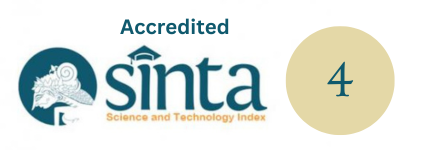New Technique of Playing Reong into Musical Composition “Sekunder” | Teknik Baru Memainkan Reong Dalam Komposisi Karawitan “Sekunder”
DOI:
https://doi.org/10.59997/jurnalsenikarawitan.v2i2.420Kata Kunci:
Teknik Baru, Reong, Komposisi Musik, SekunderAbstrak
Karya musik Sekunder merupakan sebuah karya komposisi karawitan yang terinspirasi dari proses membersihkan gamelan. Proses membersihkan gamelan bukan kegiatan utama melainkan kegiatan tambahan dalam pemeliharaan gamelan. Berangkat dari hal tersebut penata melihat suatu cara pandang baru dalam berkomposisi Karawitan. Penggunaan amplas sebagai sarana eksplorasi bunyi dari instrumen gamelan reong dan peran di luar musisi yaitu soundman adalah objek penciptaan karya yang diberi judul Sekunder. Tujuan terciptanya karya Sekunder ini untuk menghasilkan cara baru dalam memainkan reong sehinga nantinya bisa menjadi tehnik baru untuk kedepanya dalam memainkan instrumen reong. Metode penciptaan karya Sekunder disusun melalui tiga tahapan penciptaan yaitu tahap penjajagan, percobaan, dan pembentukan. Dari ketiga tahap tersebut maka terbentuk karya Sekunder menjadi 3 bagian dimana setiap bagian menggambarkan masing-masing dari tahap penciptaan tersebut dan juga implementasi dari proses membersihkan gamelan menjadi suatu teknik baru dimana cara memainkan instrumen reong menggunakan amplas. Kesimpulan dari karya ini adalah karya ini mengunakan tehnik baru dalam memainkannya yaitu menggunakan amplas dimana tehnik ini terinspirasi dari porses membersihkan gamelan. Selain itu, peran soundman sangat penting disini sebagai pengatur dinamika. Karya Sekunder ini diharapkan nantinya menjadi pijakan untuk karya-karya selanjutnya dan juga cara baru dalam memainkan reong pada karya ini bisa digunakan secara terus menerus.
Unduhan
Referensi
A.A.M.Djelantik. (2004). Estetika Sebuah Pengantar (2nd ed.). Masyarakat Seni Pertunjukan Indonesia (MPSI).
Abdul Sjukur, S. (2012). Virus Setan Risalah Pemikiran Musik. Art Music Today.
Adi, I. K. K. (2020). Kompleksitas Tabuh Kreasi Baru Gong Kebyar Sang Nyoman Putra Arsa Wijaya. Sorai: Jurnal Pengkajian Dan Penciptaan Musik, 13(1), 73–88. https://doi.org/10.33153/sorai.v13i1.3177
Ardiana, K. A. N. K. S. (2021). Pengantar Karya Seni Karawitan “Achromatic.” Ghurnita, 1(2), 108–116. https://jurnal2.isi-dps.ac.id/index.php/ghurnita/article/view/214
Arya Sughiartha, I. G. (2012). Kreativitas Musik Bali Garapan Baru. ISI Denpasar.
Banoe, P. (2003). Kamus Musik. Kanisius.
Daniswara, I. P. (2021). Megineman Sebuah Komposisi Karawitan Kreasi Baru. GHURNITA: Jurnal Seni Karawitan, 1(2), 134–142. https://jurnal2.isi-dps.ac.id/index.php/ghurnita/article/view/335
Gita, G. R. S. N. W. M. S. (2021). Musical Composition “Sedimentasi” | Komposisi Karawitan “Sedimentasi.” GHURNITA: Jurnal Seni Karawitan, 01(01), 20–28. https://jurnal2.isi-dps.ac.id/index.php/ghurnita/article/view/148
Kariasa, I. N., & Putra, I. W. D. (2021). Karya Karawitan Baru Manikam Nusantara. Mudra Jurnal Seni Budaya, 36(2), 222–229. https://doi.org/10.31091/mudra.v36i2.1471
Pangestu, J. D., & Wafa, M. U. (2019). Peran Sound Engineer Dalam Pertunjukan Musik Keroncong Di RRI Semarang. Seni Musik, 8.
Rustopo. (2010). Gamelan Kontemporer di Surakarta. ISI Press Solo.
Santosa, H. (2005). Pengetahuan Multimedia Jilid 1.
Sudirana, I. W. (2019). Tradisi Versus Moderen: Diskursus Pemahaman Istilah Tradisi dan Moderen di Indonesia. Mudra Jurnal Seni Budaya, 34(1), 127–135. https://doi.org/10.31091/mudra.v34i1.647
Syarifuddin, M. (2016). Analisis Tentang Aktifitas Buruh Tani Dalam Memenuhi Kebutuhan Pokok di Kelurahan Bukuan Kecamatan Palaran Kota Samarinda. Sosiatri-Sosiologi, 4.
Yudana, I. G., & Haryanto, T. (2021). Contemporary Music Composition “Embryo”| Komposisi Musik Kontemporer “Embrio.” GHURNITA: Jurnal Seni Karawitan, 1(1), 1–10. https://jurnal2.isi-dps.ac.id/index.php/ghurnita/article/view/147








